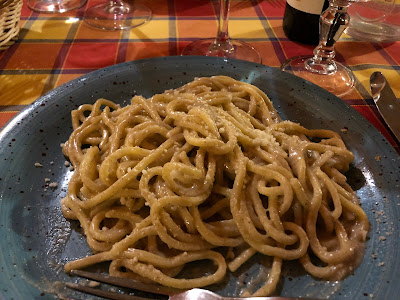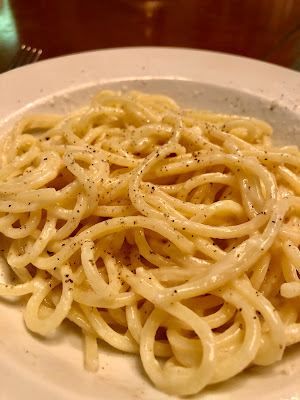Is there a better place than the Eternal City? Everyone should go at least once in their life. It is truly breathtaking and dripping with history. We checked into the Hotel Hiberia located in a palace in the historical center of Rome. The lovely gentleman at the front desk said, "I have given you a room with amazing views!" I thanked him and when we entered our room I was shocked to say the least! Not only did it have views of almost all of Rome's landmarks, it was a corner room with two windows, and the view from the bathroom was just as stunning! My daughter and I now joke that it will always be the best bathroom in the world! Haha!
After a long day of walking and enjoying la dolce vita, we were starving! I knew exactly what I wanted, one of Rome's four classic pastas, "Cacio e Pepe!" Cacio is a local Italian word meaning cheese from the Latin word caseus. So it's basically pasta with Pecorino Romano, black pepper and mixed with pasta water to emulsify into a mesmerizing sauce of simplicity. However, don't let the minimal ingredients fool you into thinking it's easy! It's all about technique and practice!
We ate at L'Hostaria Boschetto in the Monti District. With it's charming stone arches and everything porcini, I highly recommend visiting! I ordered the Tonnarelli Cacio e Pepe to see what all the fuss was. Verdict? Delicious! In fact, the couple next to us asked what I ordered and they nodded in satisfaction saying, "It is the best!"
 |
| Tonnarelli Cacio e Pepe from L'Hostaria Boschetto. |
I've been testing every recipe out there to achieve the best version for the home cook. I tried one where you toast the pepper then simmer in pasta water, but found it unnecessary. One fidgety one that alternated heat from simmer to off, then on again, etc. only to have the cheese separate into a total disaster! Also, any recipe that calls for olive oil, cream, or anything else would have the Romans throw you in the Tiber River! Romans have an intense loyalty to their culinary traditions! In fact, one of Stanley Tucci's Searching for Italy shows featured a restaurant that used half Romano and half Parmesan in their Cacio e Pepe. Gasp! Turns out the Roman's refuse to eat there and it's just for tourists basically now.
After all my testing, I have decided that Katie Parla's "Cacio e Pepe Leonardo Vignoli," from her book Tasting Rome, is the best and easiest to achieve the desired result. While the pasta cooks, you add a ladle full of starchy pasta water to the grated cheese in a large bowl with the pepper and mix. When the pasta is cooked, transfer to the bowl, stirring constantly, adding leftover pasta water as necessary to achieve a smooth sauce. Remember the pasta will continue to absorb water so it's better to be a little more on the "wet" side. The classic pasta for Cacio e Pepe is tonnarelli, which I picked up while there. If tonnarelli is not available, buying a high quality spaghetti (not Barilla or Cervasi) is very acceptable. The strands should look a little scruffed up by the bronze dies to help the sauce adhere. Good luck!
*If you want to practice making a single serving use 3 oz pasta, 2 oz Pecorino, and 1/4 tsp black pepper!*
 |
Simplest ingredients!
|
Cacio e Pepe di Leonardo Vignoli
 |
| Turned out great! Finally! |
Serves 4-6
Ingredients:
1 pound high quality tonnarelli or spaghetti
2 cups finely grated Pecorino Romano (I recommend purchasing Locatelli Grated Pecorino Romano. I am usually a stickler for freshly grated, but it's a very hard cheese!)
2 teaspoons freshly ground black pepper
*Do Not Add Salt except for the pasta water. Pecorino is Very Salty!*
Directions:
Bring a large pot of water to a rolling boil over high heat. Salt the water. When the salt has dissolved, add the pasta and cook until al dente.
Meanwhile, in a large bowl, combine 1 1/2 cups of the Pecorino Romano, the pepper, and a small ladle of pasta cooking water. Using the back of a large wooden spoon, mix vigorously and quickly to form a paste. (Personally, I have found that adding a regular size ladle of water or two and whisking to a cream soup consistency works just as well.)
When the pasta is cooked, use a large strainer to remove it from the cooking water and quickly add it to the sauce in the bowl, keeping the cooking water boiling on the stove. Toss vigorously, adjusting with additional hot water a tablespoon or two at a time as necessary to melt the cheese and to obtain a juicy sauce that completely coats the pasta.
Plate and sprinkle each portion with some of the remaining Pecorino Romano and pepper to taste. Serve immediately.
Recipe from Tasting Rome, by Katie Parla and Kristina Gill.
*I like Chianti with this recipe.*





No comments:
Post a Comment